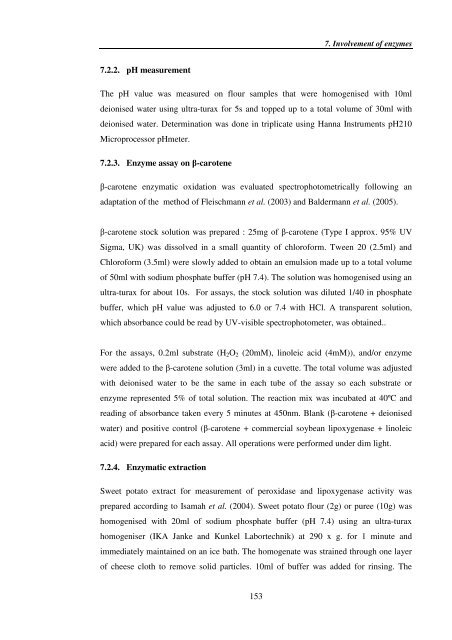Investigating carotenoid loss after drying and storage of
Investigating carotenoid loss after drying and storage of
Investigating carotenoid loss after drying and storage of
Create successful ePaper yourself
Turn your PDF publications into a flip-book with our unique Google optimized e-Paper software.
7.2.2. pH measurement<br />
153<br />
7. Involvement <strong>of</strong> enzymes<br />
The pH value was measured on flour samples that were homogenised with 10ml<br />
deionised water using ultra-turax for 5s <strong>and</strong> topped up to a total volume <strong>of</strong> 30ml with<br />
deionised water. Determination was done in triplicate using Hanna Instruments pH210<br />
Microprocessor pHmeter.<br />
7.2.3. Enzyme assay on !-carotene<br />
!-carotene enzymatic oxidation was evaluated spectrophotometrically following an<br />
adaptation <strong>of</strong> the method <strong>of</strong> Fleischmann et al. (2003) <strong>and</strong> Baldermann et al. (2005).<br />
!-carotene stock solution was prepared : 25mg <strong>of</strong> !-carotene (Type I approx. 95% UV<br />
Sigma, UK) was dissolved in a small quantity <strong>of</strong> chlor<strong>of</strong>orm. Tween 20 (2.5ml) <strong>and</strong><br />
Chlor<strong>of</strong>orm (3.5ml) were slowly added to obtain an emulsion made up to a total volume<br />
<strong>of</strong> 50ml with sodium phosphate buffer (pH 7.4). The solution was homogenised using an<br />
ultra-turax for about 10s. For assays, the stock solution was diluted 1/40 in phosphate<br />
buffer, which pH value was adjusted to 6.0 or 7.4 with HCl. A transparent solution,<br />
which absorbance could be read by UV-visible spectrophotometer, was obtained..<br />
For the assays, 0.2ml substrate (H2O2 (20mM), linoleic acid (4mM)), <strong>and</strong>/or enzyme<br />
were added to the !-carotene solution (3ml) in a cuvette. The total volume was adjusted<br />
with deionised water to be the same in each tube <strong>of</strong> the assay so each substrate or<br />
enzyme represented 5% <strong>of</strong> total solution. The reaction mix was incubated at 40ºC <strong>and</strong><br />
reading <strong>of</strong> absorbance taken every 5 minutes at 450nm. Blank (!-carotene + deionised<br />
water) <strong>and</strong> positive control (!-carotene + commercial soybean lipoxygenase + linoleic<br />
acid) were prepared for each assay. All operations were performed under dim light.<br />
7.2.4. Enzymatic extraction<br />
Sweet potato extract for measurement <strong>of</strong> peroxidase <strong>and</strong> lipoxygenase activity was<br />
prepared according to Isamah et al. (2004). Sweet potato flour (2g) or puree (10g) was<br />
homogenised with 20ml <strong>of</strong> sodium phosphate buffer (pH 7.4) using an ultra-turax<br />
homogeniser (IKA Janke <strong>and</strong> Kunkel Labortechnik) at 290 x g. for 1 minute <strong>and</strong><br />
immediately maintained on an ice bath. The homogenate was strained through one layer<br />
<strong>of</strong> cheese cloth to remove solid particles. 10ml <strong>of</strong> buffer was added for rinsing. The






